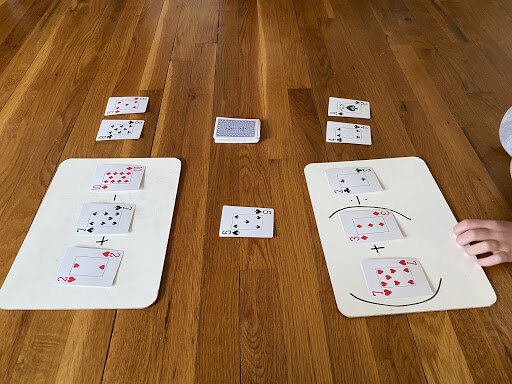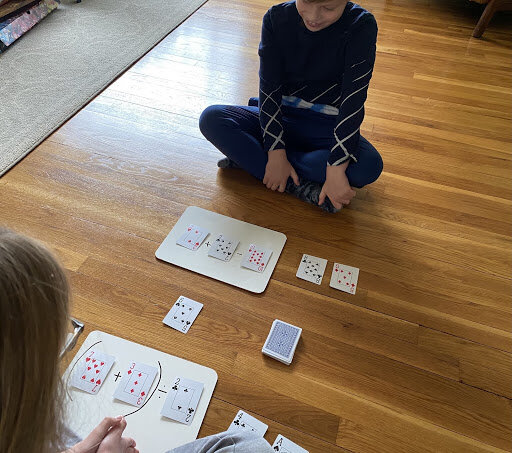There’s only one word to describe Alissa’s math workshop last week: ENLIGHTENING! It certainly provided us with a lens into today’s math teaching and methodology. The content was illuminating and the Q&A session covered thought-provoking topics.
As promised, Alissa is sharing some of her top number fluency games to keep the math conversation going at home. Although it’s only April, we know that many of you are already thinking about the summer and how to keep your children engaged while they are out of the classroom. We all want to avoid the summer slide and even more so, the dreaded summer math packet! So grab a deck of cards, read her easy-to-follow instructions, and get ready for some fun quality time with the family! Remember, keeping your children engaged is half the battle when trying to instill a love of learning…
One last thing: Alissa is available for group and one-on-one tutoring sessions, so email us any time to connect. And lastly…a HUGE thanks to Alissa’s kids for being such good sports and exemplary math game models!
how to Develop number fluency through fun exploration
Developing fluency with numbers starts with exploration. Leave the flashcards behind and give your children opportunities to play around with numbers in order to build confidence and strategy. Give them the option to use their fingers, number lines, hundreds charts, and tangible manipulatives. The more a child can visualize a number and its relation to other numbers, the more connections they can make.
A deck of playing cards might be the best tool for practicing number fluency. Below are three games that can be used with children as an alternative to flashcards. Have fun!
Head to Head
This game can be used to practice sums, differences, quotients, and products. It’s a game that not only encourages number fluency but allows students to practice communicating like mathematicians using the appropriate vocabulary. Additionally, students need to think flexibly about the operations in order to solve the mystery of the number on their heads.
Players : 3
Set up:
Remove the face cards from the deck. You can add them back in when the children are ready. (J = 11, Q = 12, K = 13)
Two players take a card from the deck and place it facing out on their forehead without looking at it.
The third player says the sum, product, difference, or quotient of the two cards. The first two players try to solve for the number value that is on their head.
Example:
Player A has a 3 card on their head.
Player B has a 6 card on their head.
Player C might say, “The sum is equal to 9!” Player A would see the 6 on Player B’s head and deduce that they must have a 3 on their own head.
War
This game is a fun way to practice all four operations.
Players: 2 or more
Set up:
Remove the face cards from the deck. You can add them back in when the children are ready. (J = 11, Q = 12, K = 13)
Deal out all the cards equally to each player. All players turn over 2 of their cards and determine the sum. The person with the highest sum gets to keep all the cards. Play continues until one player has all the cards.
Variation: This game can be played using sums, differences, and products.
Target Number
I love this game because it can be played in pairs, small groups, or independently. It's a game that allows children to use any combination of all 4 operations if they are comfortable, or just addition and subtraction if they prefer. Later on, it can be played with older students using the order of operations and introducing parentheses. This is a game that can be adaptable as children’s skillsets grow.
Players: 1 to 4
Set up:
Remove the face cards from the deck. You can add them back in when children ready (J = 11, Q = 12, K = 13)
Deal 5 cards to each player and leave them face up in front of the player.
Turn over one card and place it in the center. This is your Target Number.
Each player uses the 5 cards in front of them to create an equation that equals the target number. The goal is to use as many cards as possible. If playing against other people, the person who uses the most cards in their equation wins that round. If playing solo, the child should challenge themselves to use as many cards as possible.
For the next round, each player sets aside the cards they used and collects new cards from the center pile so that they again have 5 cards in front of them. Turn over a new Target Number. Play continues until all the cards are used up.
Example:
Target Number: 5
Cards drawn: 7, 4, 2, 3, 1
Child could play:
2 points: 4 + 1
2 points: 7 – 2
3 points: (7 + 3) ÷ 2
5 points: [(7 + 3) × 2] ÷ (4 × 1)




